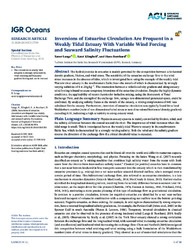Inversions of Estuarine Circulation Are Frequent in a Weakly Tidal Estuary With Variable Wind Forcing and Seaward Salinity Fluctuations
DOI: https://doi.org/10.1029/2019JC015789
Persistent URL: http://resolver.sub.uni-goettingen.de/purl?gldocs-11858/9481
Persistent URL: http://resolver.sub.uni-goettingen.de/purl?gldocs-11858/9481
Lange, Xaver; Klingbeil, Knut; Burchard, Hans, 2020: Inversions of Estuarine Circulation Are Frequent in a Weakly Tidal Estuary With Variable Wind Forcing and Seaward Salinity Fluctuations. In: Journal of Geophysical Research: Oceans, Band 125, 9, DOI: 10.1029/2019JC015789.
 |
Dokument öffnen: |
The hydrodynamics in estuaries is mainly governed by the competition between a horizontal density gradient, friction, and wind stress. The sensitivity of the estuarine exchange flow to the wind stress increases in the absence of tides, which is investigated here using the example of the weakly tidal Warnow river estuary in the southwestern Baltic Sea—the mouth of which is characterized by strongly varying salinities of 8 to 20 g kg−1. The interaction between a volatile salinity gradient and along-estuary wind forcing is found to cause temporary inversions of the estuarine circulation. Despite the highly dynamic conditions, the applicability of recent theories for isohaline mixing, using the framework of Total Exchange Flow, and the strength of the exchange flow, using a non-dimensional parameter space, could be confirmed. By analyzing salinity fluxes at the mouth of the estuary, a mixing completeness of 84% was calculated for the estuary. Furthermore, inversion of estuarine circulation was typically found for a local Wedderburn number (ratio of non-dimensional wind stress to non-dimensional horizontal density gradient) exceeding 0.33, indicating a high sensitivity to along-estuary wind.
Statistik:
ZugriffsstatistikSammlung:
- Geographie, Hydrologie [454]
This is an open access article under the terms of the Creative Commons Attribution License, which permits use, distribution and reproduction in any medium, provided the original work is properly cited.

